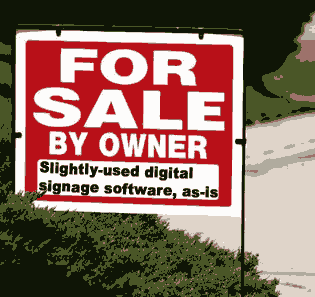 If Adrian's DailyDOOH update is to be believed (and hey, why not?), one of the more established digital signage software packages out there -- Coolsign -- is to be sold:
If Adrian's DailyDOOH update is to be believed (and hey, why not?), one of the more established digital signage software packages out there -- Coolsign -- is to be sold:Just over a month ago Planar engaged an investment banking and asset management firm with instructions to sell its Coolsign division.First off, Planar has been hurting for a while. Their stock has taken a pummeling, and now they're trying to raise cash by any means possible. While at one point they might have been able to go back to the market and sell some new shares, the current climate on Wall Street makes that close to impossible, even for a company with good financials.
Planar remember is primarily a high end screen manufacturer (and very much struggling itself at the moment) but in July 2006 it bought itself into the software arena with the acquisition of Clarity Visual Systems (Coolsign) for the not insignificant sum of USD 46 million in cash and Planar stock.
Coolsign is not surprisingly running at a loss at the moment but has revenues of USD 6.6 million. The folks looking after the fire sale are looking for a price of 3 times revenue - i.e. USD 20 Million or so.
We doubt if there will be many takers even at that price.
Yeah, I'd definitely have to agree with that last part. But the fact that Coolsign is even on the block indicates a larger problem, for Planar and perhaps for the industry at large.
However, Coolsign, with over $6M in revenue (which is pretty good for digital signage software vendors), is still running at a loss. With smaller firms like Localvision signing off, Focus Enhancements's recent bankruptcy (with more on the way), and bigger players like Broadsign and Enquii either announcing new private capital raises or admitting to having done them in the recent past, we're starting to see several factors come together in a perfect storm of digital signage doom and gloom:
1. Too much competition, not enough innovation: We track over 300 competitors -- firms that claim to sell digital signage software. Seriously, 300. There isn't enough differentiation between them, and I'd be surprised if the vast majority had fewer than 100 sites installed by now. But they suck up capital and add hype and confusion to the market.
2. Tightening credit markets mean less capital to work with: It seems like too many digital signage software companies spend WAY more than they actually make, which is a big problem now. Panicked VCs are tightening down and parent companies have less to spend on their digital signage subsidiaries. Plus, with access to credit now all but out-of-reach, fewer networks can lease equipment for new installations or factor advertisement revenue streams to stay afloat.
3. It costs a boatload to make this stuff and keep it up to date: WireSpring probably has one of the more sane cost structures out there, and we can easily spend over a million bucks a year on R&D and basic QA and support. When you consider the number of competitors I mentioned above, plus all of the guys that are building their own software to "save money" for their internal network (which is how Coolsign started, actually), you can imagine that there are very few software guys out there that are actually turning a profit, and thus very little software that generates a positive return.
So, what has to happen?
Simple. First off, there will be more messy bankruptcies and quiet "going out of business sales." Just like after the dot-com bubble, lots of companies will try to sell their half-finished, never-quite-worked-right software and other "intellectual properties." Hopefully, nobody will buy them, and they will die quiet deaths.
Next, there will be consolidation. Some industry players will band together to form better-capitalized entities with bigger customer bases. Others will choose vertical integration, forming full-service companies that can count on revenue from more than just technology.
Finally, the "builders" will eventually go away, and the "buyers" will at last win the make-buy argument. Just as practically nobody builds their own inventory or accounting systems anymore, more people will realize that making in-house digital signage software is a losing proposition. More people will turn to off-the-shelf solutions and customize them instead.
I know what you're thinking: this sounds self-promotional. After all, my company stands to win if this happens. But point out a flaw in my logic above that would suggest otherwise and I will happily debate it with you.
The bottom line: if Coolsign, with a significant revenue stream and excellent market presence, is going down, rest assured that many more will follow.
Tags: digital signage, software, coolsign, business

 As part of an ongoing effort to engage its customers and associates, Wal-Mart Stores, Inc. (NYSE: WMT) will begin a voter registration campaign with public service announcements (PSAs) on its in-store television network later this month to encourage 136 million weekly customers and 1.4 million U.S. associates to register and vote in the November elections.
As part of an ongoing effort to engage its customers and associates, Wal-Mart Stores, Inc. (NYSE: WMT) will begin a voter registration campaign with public service announcements (PSAs) on its in-store television network later this month to encourage 136 million weekly customers and 1.4 million U.S. associates to register and vote in the November elections. Subscribe to this blog
Subscribe to this blog Follow Bill Gerba on Twitter
Follow Bill Gerba on Twitter